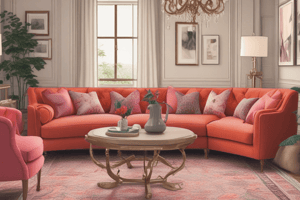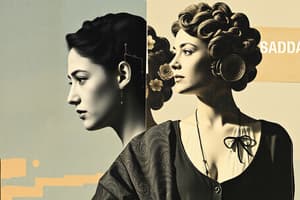Podcast
Questions and Answers
ما هو العنصر الأساسي الذي يجب توافره في التصميم الزخرفي الناجح؟
ما هو العنصر الأساسي الذي يجب توافره في التصميم الزخرفي الناجح؟
- التوازن (correct)
- التعبير
- التفاصيل
- الخلفية
الاتزان المتماثل يعني أن العناصر متساوية في توزيعها.
الاتزان المتماثل يعني أن العناصر متساوية في توزيعها.
True (A)
ما هي العلاقة التي يجب أن تكون متناسقة في التصميم الزخرفي؟
ما هي العلاقة التي يجب أن تكون متناسقة في التصميم الزخرفي؟
علاقة العناصر والوحدات والألوان.
يتمثل أحد أنواع التوازن في التصميم الزخرفي في _____ المتماثل.
يتمثل أحد أنواع التوازن في التصميم الزخرفي في _____ المتماثل.
طابق بين أنواع التوازن ووصفها:
طابق بين أنواع التوازن ووصفها:
ما هي تعريف النقطة في التصميم؟
ما هي تعريف النقطة في التصميم؟
النقطة تعتبر عنصرا فنيا لا يمكن استخدامها بشكل مستقل.
النقطة تعتبر عنصرا فنيا لا يمكن استخدامها بشكل مستقل.
كيف يمكن اعتبار النقطة في العمل الفني؟
كيف يمكن اعتبار النقطة في العمل الفني؟
تعتبر النقطة _____ في التصميم.
تعتبر النقطة _____ في التصميم.
طابق بين تعريف النقطة واستخدامها الفني:
طابق بين تعريف النقطة واستخدامها الفني:
ما هي العملية التي تحتاج إلى قدر عالٍ من الأصالة والمرونة؟
ما هي العملية التي تحتاج إلى قدر عالٍ من الأصالة والمرونة؟
التنوع في ألوان الملابس لا يلعب دوراً مهماً في تصميم الأزياء.
التنوع في ألوان الملابس لا يلعب دوراً مهماً في تصميم الأزياء.
ما هو دور المصمم في التصميم الزخرفي؟
ما هو دور المصمم في التصميم الزخرفي؟
التصميم الزخرفي يتكون من عنصر واحد فقط.
التصميم الزخرفي يتكون من عنصر واحد فقط.
ما الذي يجب أن يتناغم مع لون المكمل في تصميم الأزياء؟
ما الذي يجب أن يتناغم مع لون المكمل في تصميم الأزياء؟
اذكر عنصرين من عناصر التصميم الزخرفي.
اذكر عنصرين من عناصر التصميم الزخرفي.
تناسق الألوان يعتمد على قواعد وأسس __________.
تناسق الألوان يعتمد على قواعد وأسس __________.
يجب على المصمم مراعاة _____ عند تنظيم عناصر التصميم الزخرفي.
يجب على المصمم مراعاة _____ عند تنظيم عناصر التصميم الزخرفي.
قم بمطابقة المفاهيم المتعلقة بتناسق الألوان مع تعاريفها:
قم بمطابقة المفاهيم المتعلقة بتناسق الألوان مع تعاريفها:
قم بمطابقة العناصر الفنية مع الأدوار المتعلقة بها:
قم بمطابقة العناصر الفنية مع الأدوار المتعلقة بها:
أي مما يلي يعتبر أساسياً لضبط مقدار الراحة في المكملات؟
أي مما يلي يعتبر أساسياً لضبط مقدار الراحة في المكملات؟
الانسدال لا يؤثر على شكل إنسدال الملبس من أسفله.
الانسدال لا يؤثر على شكل إنسدال الملبس من أسفله.
ما هو تأثير الانسدال غير الجيد للمكملات على شكل التصميم؟
ما هو تأثير الانسدال غير الجيد للمكملات على شكل التصميم؟
يجب أن يكون للمكملات مقدار من الراحة لتسهيل حركة الفرد. المكملات تشبه ______.
يجب أن يكون للمكملات مقدار من الراحة لتسهيل حركة الفرد. المكملات تشبه ______.
قم بمطابقة العناصر أدناه مع مفاهيمها:
قم بمطابقة العناصر أدناه مع مفاهيمها:
ما هي النتيجة المحتملة لتنفيذ ممارسات صديقة للبيئة في صناعة الملابس؟
ما هي النتيجة المحتملة لتنفيذ ممارسات صديقة للبيئة في صناعة الملابس؟
تنفيذ ممارسات صديقة للبيئة سيكون له تأثير سلبي على صناعة النسيج.
تنفيذ ممارسات صديقة للبيئة سيكون له تأثير سلبي على صناعة النسيج.
ما الذي يمكن أن يعزز الاستدامة في صناعة الأزياء؟
ما الذي يمكن أن يعزز الاستدامة في صناعة الأزياء؟
إذا بدأت كل علامة تجارية في تنفيذ ممارسات __________، ستصبح صناعة النسيج أكثر استدامة.
إذا بدأت كل علامة تجارية في تنفيذ ممارسات __________، ستصبح صناعة النسيج أكثر استدامة.
طابق بين العلامات التجارية وأثر ممارساتها البيئية:
طابق بين العلامات التجارية وأثر ممارساتها البيئية:
Flashcards
النقطة
النقطة
في الهندسة ، هي نتيجة تقاطع خطين. في التصميم ، هي بقعة تزين سطحا ما بهيئة منتظمة.
النقطة كعنصر فني
النقطة كعنصر فني
تعتبر النقطة وحدة فنية مستقلة بذاتها في التصميم.
النقاط في الفن
النقاط في الفن
يمكن استخدام النقاط لإنشاء عمل فني متكامل.
ترتيب النقاط
ترتيب النقاط
Signup and view all the flashcards
وظائف النقطة
وظائف النقطة
Signup and view all the flashcards
عناصر التصميم الزخرفي
عناصر التصميم الزخرفي
Signup and view all the flashcards
الأشكال
الأشكال
Signup and view all the flashcards
الألوان
الألوان
Signup and view all the flashcards
الخطوط
الخطوط
Signup and view all the flashcards
النسيج
النسيج
Signup and view all the flashcards
تناسق الألوان
تناسق الألوان
Signup and view all the flashcards
لون المكمل
لون المكمل
Signup and view all the flashcards
قواعد وأسس التصميم
قواعد وأسس التصميم
Signup and view all the flashcards
التناغم اللوني
التناغم اللوني
Signup and view all the flashcards
المرونة في اختيار الألوان
المرونة في اختيار الألوان
Signup and view all the flashcards
التوازن في التصميم الزخرفي
التوازن في التصميم الزخرفي
Signup and view all the flashcards
التوازن المتماثل
التوازن المتماثل
Signup and view all the flashcards
التوازن غير المتماثل
التوازن غير المتماثل
Signup and view all the flashcards
عناصر التصميم
عناصر التصميم
Signup and view all the flashcards
نظام التصميم الزخرفي
نظام التصميم الزخرفي
Signup and view all the flashcards
مقدار الراحة للمكملات
مقدار الراحة للمكملات
Signup and view all the flashcards
الإنسدال
الإنسدال
Signup and view all the flashcards
أهمية إنسدال المكمل
أهمية إنسدال المكمل
Signup and view all the flashcards
ملاءمة الخامة
ملاءمة الخامة
Signup and view all the flashcards
خبرة المصمم
خبرة المصمم
Signup and view all the flashcards
استدامة سلسلة التوريد في صناعة الأزياء
استدامة سلسلة التوريد في صناعة الأزياء
Signup and view all the flashcards
ممارسات الإنتاج المستدام في الأزياء
ممارسات الإنتاج المستدام في الأزياء
Signup and view all the flashcards
صناعة النسيج والأزياء المستدامة
صناعة النسيج والأزياء المستدامة
Signup and view all the flashcards
تأثير ممارسات سلسلة التوريد على استدامة الأزياء
تأثير ممارسات سلسلة التوريد على استدامة الأزياء
Signup and view all the flashcards
الموضة المستدامة
الموضة المستدامة
Signup and view all the flashcards
Study Notes
Decorative Design
- Decorative design is a translation of a specific theme or a drawn idea related to the execution method and location.
- It carries specific artistic values
- It consists of multiple artistic elements interconnected with each other.
- The designer's role is to organize and combine these elements according to a specific pattern or approach that reflects their tendencies and feelings.
- This aims to achieve the practical and aesthetic goals of the product.
- Understanding decorative design elements and principles is essential.
Elements of Decorative Design
- Point: Geometrically, a point is the intersection of two lines. In design, it refers to a spot that decorates a surface in an organized manner.
- Line: A series of connected points that define a dimension and direction. It's the structural framework of the artwork, separating spaces or colors.
- Shape: Refers to the external structure or perimeter of an object. It defines the space and gives qualities to visible objects.
- Color: A fundamental design element, impacting viewers' senses directly. Its value depends on surrounding colors.
Principles of Decorative Design
- Balance: The fundamental principle in successful decorative design. It implies a harmonious distribution of elements and their colors. Types include symmetrical and asymmetrical balance.
- Rhythm: The reciprocal relationship between shapes and spaces, relying on repetition, or regular organization of the visual element.
- Unity: The relationship between design parts and the whole. It does not mean similarity but rather a connection between different components creating a cohesive whole.
- Symmetry: A common decorative design element. It's a design where one half is a mirror image of the other. It can be complete bilateral symmetry or composed of two identical elements facing each other.
- Asymmetry: Refers to a sense of difference between items. It extends beyond color values, encompassing differences in size and complexity.
- Repetition: Appears in various decorative systems containing more than two elements, characterized by a complete resemblance.
- Proportion and Harmony: A relationship between things, proportions being the cornerstones in artistic works. Proper use achieves balanced beauty in artistic elements, leading to complete artistic work.
- Contrast: Differentiating elements. Implies stimulation and isn't limited to color intensity but also encompasses shifts from simplicity to exaggeration.
Computer Use in Decorative Design
- Computers offer multiple features, aiding advancement in diverse disciplines.
- They assist designers in performing tasks efficiently and accurately.
- Popular design software includes Photoshop and Illustrator.
Design Considerations for Clothing Accessories
- Size and Shape: The accessory's exterior dimensions should fit the overall shape (silhouette).
- Body Shape: The accessory placement and how it affects the body's appearance.
- Overall Design: The accessory's lines and ornamentation need to match the garment's design.
- Line Matching: Accessory lines should align with garment lines for added aesthetic appeal and distinction.
- Spatial Connection: Accessory's position in relation to other areas, it doesn't necessarily imply equal areas; one can dominate and draw attention.
- Functionality and Aesthetics: Accessories should combine practicality and visual appeal.
- Fabric Compatibility: The accessory materials should harmonize with the garment fabric.
- Color Coordination: Accessory and garment colors should complement each other.
- Comfort and Movement: The accessory should be comfortable and not hinder movement.
- Balance/Distribution: Crafting a balanced design placement is vital for visual appeal and a complete design.
- Materials and Techniques: Designers need expertise in materials to create unique designs.
- Cultural Influences: Cultural norms and values impact accessories.
Factors Influencing Accessory Design
- Aesthetic Value: The primary goal of interconnected elements, harmony, and elements reflecting artistic qualities.
- Functionality: Understanding the accessory's practical needs determining the material choice and design to ensure it fulfills its purpose.
- Technical Aspects: Expertise in materials, tools, and methods impacting a successful design.
- Human Factors: The wearer's personality, physical traits, and economic considerations.
- Fashion Trends: Adapting to evolving trends in design and shaping accessory choices.
Sustainable Fashion
- Fashion is a significant environmental concern (second only to oil)
- The EU initiative "European Action Plan for Textiles" aims to improve textile sustainability significantly by 2019.
- Companies and fashion shows are recognizing the economic benefits of using waste effectively.
Studying That Suits You
Use AI to generate personalized quizzes and flashcards to suit your learning preferences.




